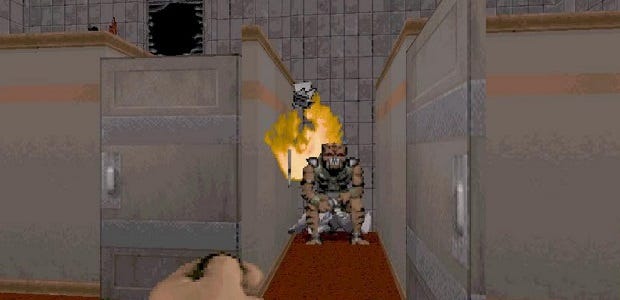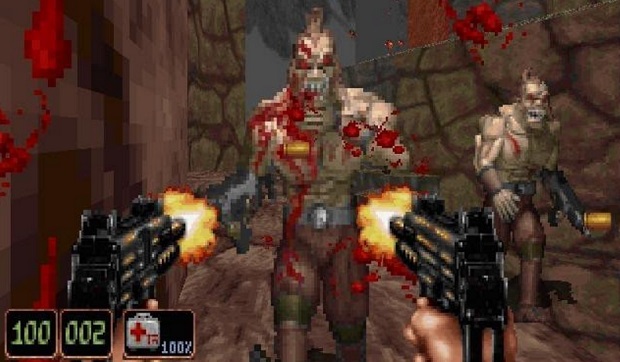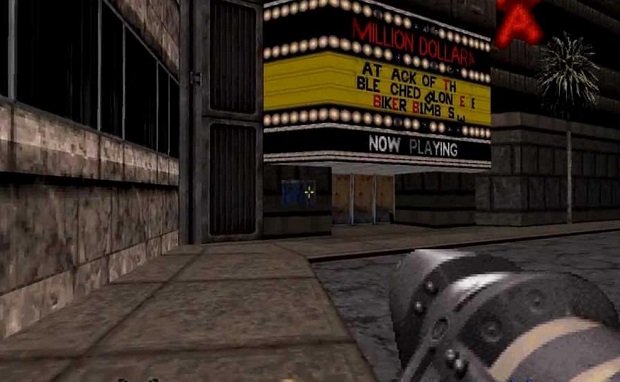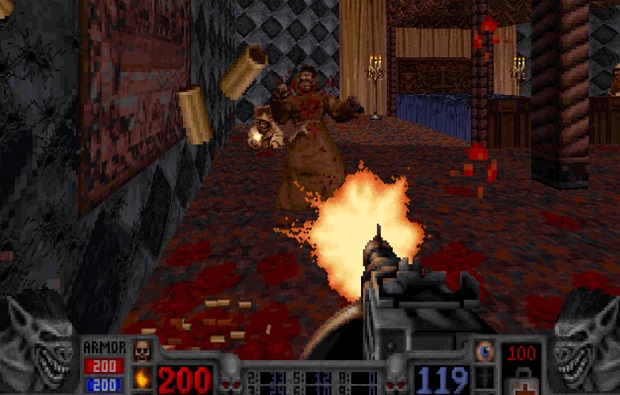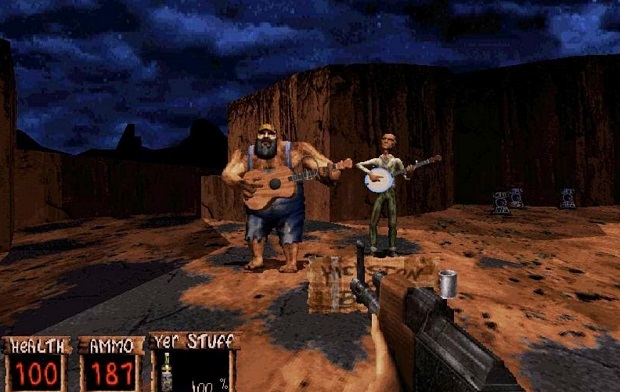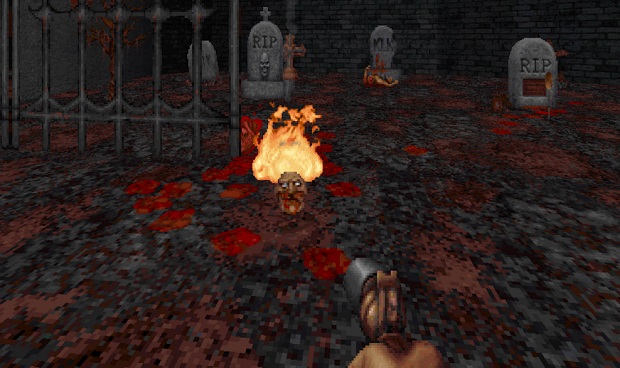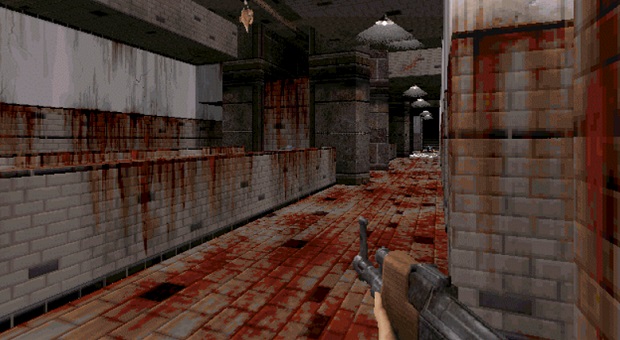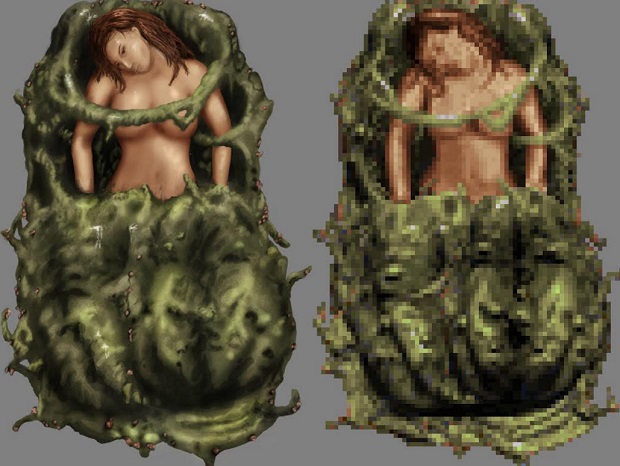Blood, Sweat & Laughter: The Beauty Of The Build Engine
2.5D remembered.
When I think of gaming in the mid 90s, I think of a unique kind of grunginess. It’s like my mind’s got its finger on the Shift key with its left hand, and the Up arrow with its right, gliding swiftly through the sordid corridors of crematoriums, porn cinemas, hillbilly backwaters and dojos. But despite their muted tones of muddy browns and tombstone greys, these spaces were anything but dreary, brimming with richly-animated sprites, the promise of gory violence around every corner, and a tongue-in-cheek energy that felt clandestine, fresh, and fiendishly fun.
When I think of gaming in the mid 90s, I think of Build Engine games.
In context of the bleeding-edge engines of today, which host tens of games across multiple genres, to declare yourself a fan of one seems like a useless generalisation. But only a handful of games - all first-person shooters, all 2.5D - ever came out for Build. Among this hallowed few were Duke Nukem 3D, Shadow Warrior, Blood and Redneck Rampage, and between them they created a special gaming moment in the year or so leading up to John Carmack’s id Tech 1.5 engine for Quake, which brought an end to the golden age of 2.5D.
Aside from 3D Realms’ Duke 3D and Shadow Warrior, these games were made by different developers, yet were all bound by a dynamism and grindhouse attitude that completely enthralled a version of me that was definitely too young to play them at the time, but unable to resist their promise of comical ultra-violence. Going back to them today, their charms and presentation transcend the ages, making me proud of underaged me for exhibiting such good taste from such a young age. “Keep going at it, kid”, I’d have said, “keep playing the games your mum doesn’t want you to and you’ll grow up to be just like me”.
It’s easy to divvy first-person shooters into the broad categories of ‘2.5D’ and ‘3D’ - pre-Quake and post-Quake. Within the former category, it’s almost sacrilegious to not go on about Doom as the defining game of this era, but between Doom in 1993 and Blood in 1997, the 2.5D shooter went through an impressive evolution. With the launch of Duke 3D in 1996, made using Build, levels became more realistic and verticalised, characters delivered silly one-liners, and sprites became beautiful and lively - 3D computer-made models condensed into 2D sprite form, with shading, movement, and death animations far surpassing the murky polygonal Lego-baddies of Quake (running at a measly low frame-rate, because who had a PC capable of running it at 60fps?).
Pitchfork a zombie in the face in Blood, and its head will fly off, leaving the neck-stump spraying blood in all directions before staining the floor for tens of feet around the body. Find the head, and you can kick it around like a blood-spurting football. In Duke 3D, we all remember shotgunning a grunt alien while it was having some quiet time in the loo - instantly killing it, destroying the crapper to turn it into a perfect water fountain, and leaving a large blood splatter trickling down the wall. Even today, such dynamism is rarely seen in shooters, yet the Build games nailed it.
The environments in Build games were uniquely interactive and grounded in reality. Up to that point (and for a few years after it, with Unreal, Quake and their derivatives), shooters took place in netherrealms - metallic bases on distant planets, alien hives, or maybe vaguely fantasy-themed yet equally implacable mazes that seemed to exist for the sole purpose of you shooting stuff in them; you pick up coloured cards, you press big buttons on walls, you kill kill kill without uttering a word.
But Build games took the action to urban centres, morgues and small-town Americana. We were whisked away to more fantastical worlds by Shadow Warrior and the wonderful Outlaws (not a Build game, but also among the last 2.5D shooters, and one of my favourite FPSes of all time, so I’m mentioning it, OK?), which took place in Japan and the old west. What unified all these environments is that they felt like real spaces designed for humans to reside in, but which just happened to be beset by zombies, aliens, or foul-mouthed shotgun-wielding hillbilly clones (that’s Redneck Rampage, in case you were wondering).
Beneath their veneers, these environments may have been just as mazey and confusing as those of preceding shooters, but they were the first time I experienced 3D game spaces that made an effort not to feel gamey. Getting lost in them actually felt more fun than tiring thanks to their stabs at realism and panoplies of secret little interactions to be had. And by that, I don’t just mean pulling a switch to uncover a secret area behind some random wall containing a weapon and some health packs. I mean a layer of whimsical interactivity that can best be described as ‘Pointless Shit’.
Duke Nukem 3D set the precedent for Pointless Shit, letting players engage in activities that weren’t goal-based, or even terribly exciting when you think about them - take a piss, turn on a tap, look in the mirror, knock some snooker balls into each other, watch an adult movie. But such activities bolstered Build games’ curious sense of realism beyond that in anything else I played at the time. Running around at that 90s shooter breakneck pace, I’d shoot or hit Space at everything I encountered, just on the off-chance that the environment would react in some novel way. And often it would - shoot some whiskey bottles in Outlaws, flick light switches or play an organ in Blood, or chase some chickens around with a shotgun in Redneck Rampage... because why not?
These trivial interactions fed into the games’ carefree and edgy personalities. Each was fronted by a protagonist with things to say and insults to throw. Aside from the well-known Duke-isms, we got nuggets of rural American wit from Redneck Rampage’s Leonard (“Boy, you are slower than shit through a funnel”), Lo Wang uttering ‘You half the man you used to be” in Engrish as he slashes an enemy in two, and Blood’s Caleb raspily singing the lyrics to The Good Ship Lollipop, before admitting that he’s forgotten the words. Enemies were equally expressive, and if they weren’t shrieking insults at you they’d be giggling maniacally while peppering you with bullets, or even spasming in death throes once you’ve finished them off. Their energy was unmatched, and as far as I was concerned Quake could keep its damn polygons and sewer-like environs.
Behind all this was Ken Silverman’s Build Engine, working away in the furnaces beneath the surface of the non-stop party occurring on our screens. I managed to get hold of Silverman via email. He described himself as a ‘one-man engine team’ when working on the Build Engine under contract for 3D Realms, essentially learning as he was going along, with little guidance from those around him. In fact, his early guidance came from a seemingly unlikely source: “In the beginning, they had me talk with John Carmack by phone,” he said. “I learned about sectors that way. Besides that, 3D Realms wouldn’t have known how to help me, at least on the engine side”.
While the art design that went into Build games was fantastic, it wouldn’t have been possible without the Build Engine’s in-built 3D editing mode - the first one ever used in a first-person shooter, according to Silverman. “The WYSIWYG Build Editor featured editing in 3D mode, using the same rendering core as the game itself.” Essentially, this made working on 2.5D games much quicker than ever before, allowing designers to spent more time fine-tuning the textures, shading, ceiling and floor heights, and slopes in their games.
But even though it did such a great job of depicting 3D space, the Build Engine was in fact a wonderful case of smoke and literal bloody mirrors. Getting into an elevator or water actually teleported you to different parts of the level, mirrors were segments of wall with an inaccessible space behind them housing a secret cameras to create a reflection effect, and skies in ‘outdoor’ areas were just ceilings with a parallax effect applied to them. Even that putrescent, grungy colour palette I mentioned earlier - so well suited to the tone of the games - arose from an engine limitation.
“This [the colour palette] had to do with the shading system. As objects got farther away from the camera, they were rendered darker until eventually it reached black,” said Silverman. “In order to support this without sudden jumps in color, each hue needed a bunch of darker versions of itself. This highly limited the number of hues one could select for a game.”
The engine was filled with plenty of quirks like that, arising from the way it models space. In Duke Nukem 3D, you’ll never look at a building from the outside and see into two different rooms, one above the other, because you can’t have two rooms visible at the same x-y location due to the Engine’s technically 2D nature. If you had more than a single portal (or view) looking through to another sector (or room/area of the map), then the rendering method would cause a ‘Hall of Mirrors’ effect - an error caused the game to go into an infinite processing loop between the portals and the player.
This was later worked around using a plucky hack in Shadow Warrior, Blood and Redneck Rampage: “It worked similarly to mirrors in that once the mirror (or ceiling/floor portal) texture was identified, the game code would render the sectors on the opposite side of the portal first, in a separate pass”.
Of course, resorting to hacks and tricks to give the illusion of continuity in a 3D environment is indicative of technical shortcomings, and Silverman matter-of-factly admitted that Build “could not compete with Quake”. When I jumped to its defence, lauding it as the pinnacle of pixelated shooters, and wondering whether we missed out on a slew of wonderful Build games because of the industry’s blind rush towards fully 3D engines, he pulled no punches on his own creation. “We all knew Build was obsolete at the time”, he said. “It lacked true look up and down, fancy shading, polygonal sprites, and drop-in networking” - all features offered by Quake’s id Tech 2 engine.
Even though id’s engine had a clear edge on a technical level, I maintain that the explorable spaces and coarse yet rich pixel-art graphics of Build games outshone those of all other shooters until Half-life launched in 1998. How much of that is owed to the engine itself is incalculable, and when I declared that the 2.5D style of Build games was unmatched by anything else for years afterwards, Ken quipped, “I'm sure they could have used billboard sprites in Quake if they had wanted to”.
While Build zealots, myself included, like to foment the idea of a feud between the Build and id Tech engines, it seems that the reality was far more civil. In addition to Carmack’s words of wisdom for Silverman, there was plenty of dialogue between the two camps. “Id Software was a short drive away from the 3D Realms office”, Ken told me. “We often had groups of people visit so nothing was completely secret. Interestingly, E1L6 (episode 1's secret level) of Duke Nukem 3D had a room with sloped ramps on the outer walls (in an L-shape) that was inspired by an early screenshot of Quake.”
Today, the Build engine is a worthy stop-off point on gaming’s endless road to progress; on this figurative road, it’d be demarcated in the UK by a (fittingly) brown road sign pointing to a great castle that was built just a year before cannons became the ‘in thing’ in war, rendering it obsolete. Its historical interest endures, as modders continue to flock to the Engine like intrepid archaeologists trying to decipher grinding-stone puzzles in ancient temples - exploring it, tweaking it, smoothing the jagged edges of the pixelated graphics or replacing them with 3D textures, and solving its legendary quirks.
Admirable though the modding community’s work is, I prefer to keep my nostalgia blinkers firmly on. There is something magical about the graininess of those pixelated characters, their withheld visual fidelity infusing them with a rich texture and air of mystery that, when refined and upscaled, ends up looking cartoony, even crass. Likewise, quadrupling the texture resolutions and replacing the sprites with 3D models is a testament to the community’s passion for these games, but lacking the quality that keeps me returning to these pixel playgrounds.
The Build era was a moment in PC gaming history that’s certainly not been forgotten, but came just before a technological revolution that cut its gloriously grimy tenure short. Only when Half-life came out did I finally get over the Build era. But until that point, and then six years ago when I, along with the rest of the gaming world, rediscovered my love for pixel graphics, I bemoaned that the era didn’t last just a little bit longer, delivering several more vivacious 2.5D shooters while Quake, Unreal and co. worked out how to imbue a 3D game with some of that great Build spirit.
Upon reflection, maybe part of the Build era’s magic came from its ephemerality, which meant that it only had a small, thematically inseparable games roster to be judged by. It was an explosive Last Stand of an era that began back with Doom in 1993, treating us to a beautiful illusion of 3D while we waited for the inevitable ‘real thing’. But the illusion was so great that for years the real thing struggled to match it.
These games point a confident, bloodied middle finger to 3D shooters that have come and gone across the generations. For while almost every shooter since Quake is doomed to date and be judged by the latest standards of the day, the Big Four Build games remain immortal.
